![]()
![]()
![]()
Use LEFT and RIGHT arrow keys to navigate between flashcards;
Use UP and DOWN arrow keys to flip the card;
H to show hint;
A reads text to speech;
26 Cards in this Set
- Front
- Back
- 3rd side (hint)
|
Memory |
The process of storing and retrieving information from and about the past. |
In psychology memory is the process which we retain information about events that have happened in the past. |
|
|
Sensory memory |
Initial contact for stimuli, is only capable of retaining information for a very short time. E.g: 2 seconds. |
The 5 senses. |
|
|
Short term memory |
The information we are currently aware of or thinking about. The information found in the short term memory comes from paying attention to the sensory memory. |
It usually contains 7 plus or minus 2 chunks of information. |
|
|
Long term memory |
Continual storage of information which is largely outside of our awareness shut can be caused into working our memory to be used when needed. Capacity is unlimited. |
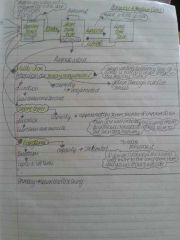
|
|
|
Key words |
Rehearsal- A way to transfer information to the LTM.
Encoding- to remember things, we put info into our brains.
Duration- how long the info stays in the sensory memory.
Semantic- attaching a meaning to something.
|
Must learn. |
|
|
STUDY- Craik and Lockhart |
Their aim was to see if the type of question asked about words will have an affect on the number of words recalled. His method was to present the participants with a list of words and one at a time asked questions. Some required structural processing whereas others semantic processing and phonetic. After they were given a long list of words whilst asked to ask questions. Their results showed that participants had identified 70% of the words required semantic processing and 35% phonetic. 15% structural. Concluding that more deeply information is processed, the more likely it is to be remembered. |
Level of processing model of memory was investigated. |
|
|
Eye witness testimonys |
Factors that affect eye witness testimonys- 1) leading questions- When questions imply there WAS a man in a red jumper and the respondent is likely to agree. 2) unfamiliar faces- We are not very good at identifying familiar faces.
STUDY- Lotfus and Palmer- To see if asking leading questions affect the accuracy of recall. Method- all shown films of accidents. Some asked 'how fast was the car when it hit the other car?' And some asked 'how fast was the car when it smashed the other car?' Results- those who heard the word 'smashed' gave a higher speed estimate than those who heard 'hit' Conclusion- Leading questions will affect the accuracy of recall.
|
We are sometimes persuaded to act in a socially desirable way. |
|
|
Stereotyping- Stereotyping is an oversimplified and generalised set of ideas about others. |
Prejudice- A rigid set of attitudes or beliefs towards a particular group of people. |
Discrimination- The way an individual behaves towards another person as a result of their prejudiced views. |
|
|
STUDY- Rubin et al |
To find out if new parents stereotype their babies. Method- parents were asked to describe their baby within 24 hours of being born. Results- parents of new baby boys described them as alert and strong. Parents of baby girls,soft and delicate. Conclusion- Parents sterotype their children from a very early stage despite no stereotypical behaviour being shown. |
Stereotyping |
|
|
A paragraph of how the social media generalise to specific genders |
The social media aim their TV shows and films for certain genders. For many years now they have been stereotyping programmes basing each on certain gender. As for the boys, the films seem to contain action and for girls, princesses. Although, as the years have progressed on they have begun letting girls be heroes themselves. Stereotyping in childrens media have changed over the years resulting that it is okay for children to be themselves. It also shows the equality between the two sexes. |
Question. |
|
|
Advantages and disadvantages of stereotyping |
Advantages- help us to remember information about other people. Help us fit in with others. Disadvantages- most are negative and promote harm. Once learnt it is hard to overcome. |
Everybody stereotypes, whether it be negative or positive. |
|
|
Prejudice and discrimination |
Why are we prejudiced? Tv reporter- sex discrimination Age discrimination when a woman switched with a younger female. |
SHERIF- STUDY! To find out if predijuce develops when groups are in competition. Method- an American summer camp was organised for 22 boys. All randomly split into two groups, and kept away from each other. Not aware of the other teams existence. All given time to settle in and form group identity. After a while they discovered each other and were given competitions. Results- very quickly, teams began unpleasant name calling and tried attacking eachother. Concluding that competition is the cause of prejudice.
Evaluation- -Boys were American so cant generalise. - has real life implications. Quickly demonstrated how fast prejudice occured. |
|
|
Study- Levine |
To see if people would be more likely to help a stranger if they believed they had something in common with them. Method- A situation was set up where a man fell over in front of Manchester United fans, half of the time he wore a Manchester United shirt and the other time he wore a Liverpool shirt. Results- When wearing the Manchester United shirt he was helped at all times but when wearing the Liverpool shirt he was left to help himself. Concluding that when we feel we have something in common with others we are more likely to help them in an emergency. |
We are less likely to help out group members. Out-group- a group of people you believe you have nothing in common with. In-group- a group of people you believe you have something in common with. |
|
|
Discrimination STUDY- Elliot |
To teach her class what it felt like to be discriminated against. Method- Elliott showed her class some of the following: -blue eyed children are smart -blue eyed children are the best -brown eyed children cant use the drinking fountain Results- the reaction from the students were immediate. The blue eyed children were delighted and became vicious. The brown eyed were angry and upset. Fights even broke out. The following day she reversed this and the brown eyed children behaved the same way as the blue eyed children did before. Concluding that by getting children to experience firsthand what its like to be victims themselves of discrimination they will grow up to be more tolerant towards others. |
Not generalised to others though. |
|
|
Personality - The thoughts, feelings and behaviours that make an individual unique. |
Study- Kegan and Snidman Test whether temperament is due to biological differences. Method- for the first minute the baby was placed in a seat with the caregiver near. For the next three minutes the caregiver moved out of the baby's view and the baby was shown toys. Results- 20% of the babies cried and moved alot, highly reactive. 40% were little movement. 11 years later, found that the same children still had a difference in how they reacted. The high reactive were shy while the low were calm. Concluding that the two temperaments are due to inherited differences in the way the brain responds.
|
Temperament- this is constant and is what you inherit, it cannot be changed. |
|
|
How personality is measured- Eysencks type theory |
He believed there are different personality types. Including extraversion, introversion and neuroticism. Extroverts are sociable, lively and easy going. They are open and like making friends. Introverts are normally quiet and like spending time alone. They usually don't have many friends. Neurotics are very nervous, tense, shy and moody. They lack confidence. |
Eysenck believed that these are different personality types that are caused by the type of nervous system each individual inherits. |
|
|
Eysencks study |
To investigate the personality of 700 service men. Method- Each soilder completed a questionnaire. Results- He identified two dimensions of personality; extoversim-introversion and neuroticism-stability. Concluding that everyone can be placed along these two dimensions of personality. Most lie in the middle. |
Evaluation- He only described a limited amount of personality types. And he used questionnaires meaning that the answers could have been based on their mood at that time. |
|
|
APD- antisocial personality disorder |
A condition in which the individual does not use socially acceptable behaviour or consider the rights of others. Characteristics of apd- -not following laws in society -lying and conning others -feels no remorse -being aggressive and careless Only diagnosed at aged 18.
Biological causes of APD- The amygdala is responsible for learning from the negative consequences of our actions. Its also responds to fearful and sad expressions in others. It is affected with people with APD and resulting that they do not learn to avoid behaviour. Reduction in the pre frontal cortex of grey matter has also been associated with APD. The prefrontal cortex is the area of the brain that enables people to learn social and moral behaviour and to feel guilt. |
People do not feel guilty when doing something because their prefrontal cortex has less grey matter. |
|
|
Study-Raine et al |
To support the theory that abnormalities in the prefrontal cortex cause APD. Method- MRI was used to study 21 men with APD and a control group of 34 healthy men. All volunteers. Results- the APD group had 11% reduction in the prefrontal grey matter compared to the control group. Concluding that APD is caused by the reduction in the brains grey matter. |
Evaluation- - all men,no women. |
|
|
Situational causes of APD |
APD may be caused by the situation that someone is brought up in. SOCIOECOMIC FACTORS: - Unemployment or low income -Lack of responsibility -Being in debt QUALITY OF LIFE AT HOME: -Poor parenting -Misuse of money -Unhygienic household EDUCATIONAL FACTORS- -Stress at school -Low school achievement -Leaving school at a early age |
Some factors lead to APD. |
|
|
Study- Farrington |
To investigate the development of offending and anti-social behaviour in males studied from child hood to the age of 50. Method- The researchers carried out a longitudinal study of the development of antisocial and offending behaviour in 411 males. All lived in London. First studied at aged 8, and followed up until 50. Parents and teachers too interviewed. Searches also carried to see if any were convicted of criminal behaviour. Results- 41% of the males were convicted of at least one offence between ages 10-50. Most important risk factors were poverty, poor parenting and criminal behaviour in the family. Concluding that situational factors lead to the development of antisocial behaviour. |
Evaluation- - was not a controlled experiment |
|
|
Practical implications of APD |
-If APD has a biological cause then it cannot be prevented -As researchers cannot find the cause then its difficult to find a cure to prevent it |
APD is either situational or biological |
|
|
Non-verbal communication |
Communication can be verbal or non-verbal. Verbal- Tone, Emphasis, Paralingstics and Intonation. Non-verbal- Eye contact, Facial expressions and Body language |
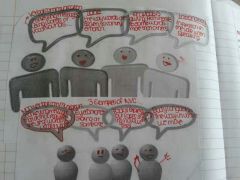
Verbal and non-verbal |
|
|
Case study |
Dauitz and Dauitz |
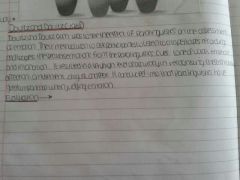
|
|
|
Argyle, Alkema and Gilmour |
To see if tone of voice has any effect when interpreting a verbal message. |
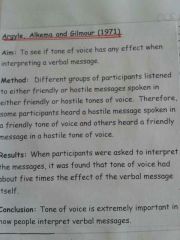
|
|
|
Eye contact |
Argyle- To see how interruption in eye contact affects conversations. Method- Pairs of participants were observed having conversations. In half the conversations one of the participants wore dark glasses so no eye contact. Results- When one of the participants wore dark sunglasses, there were more pauses and interruptions than when not worn.
Concluding that eye contact is more important in ensuring the smooth flow of conversation. |
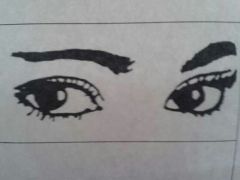
Sunglasses affect the flow of conversation. |

